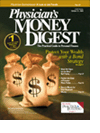Publication
Article
Physician's Money Digest
Close-Up: Exchange-Traded Funds
Author(s):
Presented by McNeil, Makers of Tylenol
n.
Exchange-Traded Funds: Shares of ownership in funds, trusts, or depository receipts that are listed on anexchange and can be traded intradaily.
As a result of unethical trading recentlyuncovered, the mutual fund industry isstruggling through a tarnished image andworking to establish reforms. In the meantime,exchange-traded funds (ETFs) are receiving afavorable limelight. ETFs were first introduced on theAmerican Stock Exchange over a decade ago to allowinvestors to buy one security that covers the entire S&P500, like indexed mutual funds, but with the tradingflexibility of stocks. ETFs now trade on all three majorstock exchanges, along with the bond market.
Makings of a Fund
ETFs are large funds made up of indexed publicholdings (normally stocks) that originate from a creationunit of about 50,000 shares. Institutions breakthese large blocks into individual pieces for investors,and then investors trade shares on the secondary marketthrough a broker. Shares are priced moment to momentand trade on an exchange throughout the day.
Each ETF share trades at market price (ie, thevalue as determined by the market forces of supplyand demand). That value is kept as close as possibleto the fund's net asset value (NAV), which is the valueof its underlying holdings, including any cash in theportfolio, calculated by dividing a fund's total netassets by its number of outstanding shares. Creationunits are priced daily at NAV, which keeps ETFs'shares from being bought and sold above or belowtheir real value.
Indexed Exchanges
ETFs' structuring employs the reliable method ofindex investing, which is also used in index funds. Veryoften, the annual fees and loads paid, along with theuncertainty of the markets, cancel out benefits of activelymanaged mutual funds, resulting in far more positivegains for indexed investment tools such as ETFs andopen-end index funds.
As with index funds, ETFs offer diversity throughtheir variety of asset classes. ETFs have four fund types,each representing different indexes: broad-based equity(eg, total market), broad-based international and countryequity (eg, European), industry-sector equity (eg,health care), and US bond (eg, long-term Treasury)indexes. Another huge ETF benefit is its tax efficiency.Like index funds, ETFs generate fewer capital gainsbecause of their securities' low turnovers.
Distinct Advantages
Note:
So, how does an ETF differ from an index fund? Forone, because ETFs sell over an exchange, they aren'trequired to sell securities to meet investor cash redemptions.This eliminates the capital gains tax liability forremaining investors. The liquidating sale of anETF would generate capital gain/loss liability.
For the most part, ETFs have lower annual expenseratios and management fees than mutual funds. SomeETFs are even lower in fund costs than bargain-basementVanguard index funds of similar asset classes.However, an ETF's purchase and sale are subject to brokeragecommissions, unlike a mutual fund's.
Due to ETFs' stock status, investors can employhedging (ie, buying ETFs on margin and selling themshort, even on a downtick), which has opened upindividual risk management strategies available onlyto large institutions in the past. ETFs also trade usingstop and limit orders (ie, orders specifying the pricepoints at which they will trade).
On the Downside
ETFs' highlights come with a few caveats. AMorningstar article points out that ETFs' commissionand trading costs can reverse their cost advantage, especiallyfor rapid traders or small investors who make regularmonthly contributions, and that investing in lowcost,open-end index funds can yield the same return asa good ETF mix, at lower overall costs.
In the MarketWatch article, John Bogle, founderof low-cost mutual fund giant Vanguard, criticizesETFs as speculative tools. Nate Most, credited withinventing ETFs, brings up his own concerns in thearticle. He points out that there are too many ETFs,saying, "You can end up slicing the market into suchtiny pieces that they begin to lose their meaning. Also,for an ETF to function properly, the stocks in thefund have to be liquid." This means some covetable,nonliquid asset classes won't work in ETFs. TheSEC's diversification requirements can make someasset classes impossible for ETFs.
Challenges notwithstanding, ETFs offer great possibilityas financial hybrids, appealing to both traders wholike their stock-like flexibility and long-term buy-and-holdinvestors who appreciate the stability of indexes.Before investing, be sure to consider their relevance toyour individual needs.
Major ETF Groups
DIAMONDs: Shares in the Diamonds Trust Series IETF that track the Dow and are structured as a unitinvestment trust.
iShares: A group of ETFs advised and marketed byBarclays Global Investors and structured as open-endmutual funds.
HOLDRs: Holding company depository receipts, atype of ETF marketed by Merrill Lynch. They do nothave creation units like other ETFs; rather, they canonly be bought and sold in 100-share increments. Theyfocus on narrow industry groups.
Qubes: A group of ETFs that track the technologyladenNasdaq 100 index and are structured as unitinvestment trusts. They are the most heavily traded ETF.
SPIDERs: Standard & Poors' Depository Receipts, agroup of ETFs that track a variety of S&P indexes,including the S&P 500 and sector indexes. They arestructured as unit investment trusts and open-endfunds, respectively.
StreetTracks: A group of ETFs managed by StateStreet Global Advisors that track various indexes. Theyare open-end funds and trade on the AMEX.
Source:
VIPERs: Vanguard Index Participation Receipts, ETFversions of several Vanguard index funds. They arestructured as share classes of existing open-end funds.Morningstar
Pop Quiz
1) On what exchange did US ETFs first trade?
- S&P 500
- American Stock Exchange
- DIAMOND
- New York Stock Exchange
2) All of the following factors are disadvantages of ETFs except:
- Trading costs
- Limited asset classes available to funds
- Too many funds in the market
- Tax inefficiency
3) How many fund types are available through ETFs?
- 2
- 4
- 10
- 50,000
4) Which group of ETFs tracks a variety of S&P indexes?
- SPIDERs
- DIAMONDs
- HOLDRs
- iShares
5) On what value do ETF shares trade throughout the trading day?
- >Market price
- Expense ratio
- Net asset value
- Dow
Answers: 1) b; 2) d; 3) b; 4) a; 5) a.
